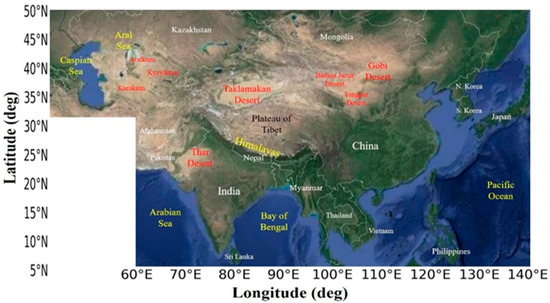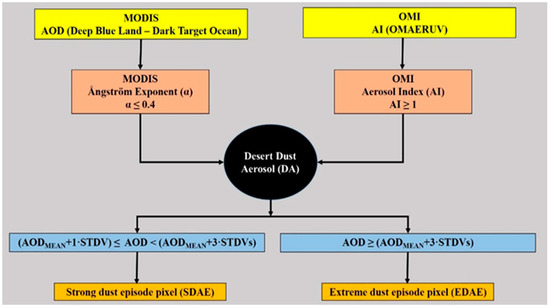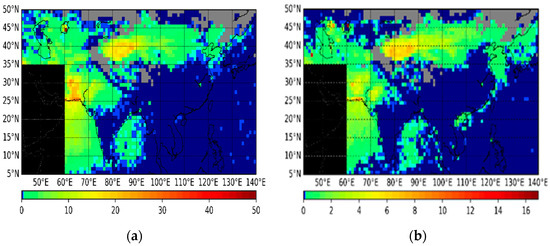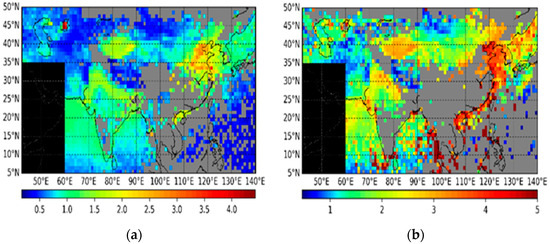Abstract
In the present study, a satellite algorithm is used to identify Dust Aerosol Episodes (DAEs) over the wide region of Asia and the Caspian Sea, aiming to determine their spatial and temporal distribution by applying threshold values on key aerosol optical properties, emphasizing their frequency of occurrence and intensity, during 2005–2021. Based on the algorithm outputs, a climatology of spatiotemporally extended Asian DAEs is built, emphasizing their interannual variability and tendencies over the 17-year study period.
1. Introduction
Dust aerosol (DA) is a major contributor to the total aerosol burden in the Earth’s atmosphere, significantly affecting weather and climate conditions, through various interactions with radiation and clouds, while also deteriorating air quality and causing adverse health effects. More specifically, DAs alter the energy balance of the Earth–Atmosphere system, as they absorb and scatter primarily the solar but also the thermal infrared radiation, thus influencing climate from the local to regional and global scales [1]. Moreover, DAs act as effective cloud condensation nuclei (CCN) or/and ice nuclei (IN), modifying this way the cloud properties, such as cover and albedo, as well as the produced precipitation [2]. The largest amounts of DAs are found in the Northern Hemisphere and more specifically in a zone which extends from the west coast of North Africa to Central Asia and is known as the global dust belt [3].
In the present study, the occurrence of Dust Aerosol Episodes (DAEs) over the wide region of Asia and the Caspian Sea is attempted using a satellite algorithm, which uses contemporary satellite data for the optical properties of aerosols and applies specific thresholds to them. DAEs have been studied in several studies, on both global [4] and regional [5,6] scales, based on (i) ground-based measurements, (ii) satellite measurements, (iii) numerical models, and (iv) a combination of the previous methods. However, our study is the first (to our knowledge) in which an investigation of the dust aerosol events (DAEs) in Asia is performed on a large spatial and temporal scale, using state-of-the-art satellite data. The selected study region (Figure 1) includes the major dust sources of the Taklamakan and Gobi Deserts in Central and East Asia, and the Thar Desert in the Indian subcontinent. Aralkum, Kyzylkum, and Karakum Deserts in Central Asia, along with other smaller arid areas contributing high dust loadings, such as the Badain Jaran and Tengger Deserts in China, are also included.

Figure 1.
The domain of the study area.
2. Data and Methodology
The occurrence of DAEs over the wide region of Asia and the Caspian Sea is identified using a satellite algorithm, which is based on aerosol optical properties. The algorithm operates on a daily basis and 1° × 1° pixel level resolution using spectral Aerosol Optical Depth (AOD) and Aerosol Index (AI) data from the Moderate Resolution Imaging Spectroradiometer (MODIS) Aqua Collection 6.1 and Ozone Monitoring Instrument (OMI) Aura near-UV aerosol product OMAERUV databases, respectively. The Ångström exponent (α) is also calculated using the MODIS spectral AOD. In the first step, the algorithm identifies the presence of DA whenever AI ≥ 1 and α ≤ 0.4. Given the identification of DA, one more threshold is applied on the AOD to ensure the unusually high (i.e., episodic) loadings. At this point, the DAEs are categorized into strong and extreme ones, when AODMEAN + 1STDV ≤ AOD < AODMEAN + 3STDVs and AOD ≥ AODMEAN + 3STDVs, respectively, where AODMEAN is the climatological mean AOD value and STDV is the associated standard deviation calculated from 2005 to 2018. The algorithm’s flowchart is shown in Figure 2.

Figure 2.
The flowchart of the algorithm used for the identification of Dust Aerosols (DAs) and Dust Aerosol Episodes (DAEs).
3. Results and Discussion
In Figure 3, the spatial distribution of the climatological mean annual absolute frequency of occurrence (episodes/year) of strong (Figure 3a) and extreme (Figure 3b) DAEs over the broader region of Asia and the Caspian Sea during the 17-year period 2005–2021 is shown. According to the results, the frequency of DAE (strong and extreme) occurrence over a great part of the study region, covering Indonesia, the Arabian Sea, south-eastern China, and the greatest part of the Pacific Ocean, is zero (deep blue colors in Figure 3), which means that no episodes were detected. Regarding the strong DAEs, the maximum values of the absolute frequency of DAEs (15 to 30 episodes/year, yellow-red colors) are observed in the Taklamakan and Thar Deserts and in the southern parts of Pakistan bordering the Arabian Sea (light green-yellow-orange shades). High frequencies (5–15 episodes/year, blue-green shades) are also noted over the western part of the Gobi, Karakum Desert, and Arabian Sea (7–18 episodes/year, blue-green shades). On the other hand, extreme DAEs are less frequent (up to 17 episodes/year) compared to the strong ones (Figure 3b). According to the algorithm results, their frequency mainly varies between 5 and 7 episodes per year over the Taklamakan and Thar Deserts, and the coastal area of Pakistan. The maximum frequencies occur over the northeast of the Caspian Sea, 5–8 episodes/year occur, which is possibly associated with the decrease in rainfall and increase in evaporation [7]. Last, extreme DAEs also take place with lower frequencies over the Arabian Sea and continental areas around the Caspian Sea (1–3 episodes/year).

Figure 3.
Spatial distribution of the climatological mean annual absolute frequency of occurrence (episodes/year) of strong (a) and extreme (b) DAEs over the wider region of Asia and the Caspian Sea during the 17-year period 2005–2021. Gray shaded areas are those for which the algorithm did not operate at all due to a lack of input data. The black area is not included in the study domain.
The spatial distribution of the climatological mean annual DOD of strong (a) and extreme (b) DAEs is shown in Figure 4. Concerning strong DAEs, the maximum DOD values (up to 3.3) are noted over northeastern China, the southwestern parts of the Gobi Desert, and the Yellow Sea (yellow and orange shades). High loadings (1 < DOD < 2) also occur over the Taklamakan and Thar Deserts, the Arabian Sea, and the Bay of Bengal (green colors in Figure 4a). Over the rest of the study region, DOD values are less than 1. High values (up to four) are also observed in Aral Lake. The main reason is that in recent decades, the gradual drying up of the lake has taken place, due to the diversion of the rivers that supplied it, turning it into a desert area [8,9,10], i.e., a new source of dust, and this explains the increased DOD values over neighboring areas. On the other hand, the DOD of extreme DAEs (Figure 4b) become maximum over the coastal areas of East Asia, with values from 3.5 to 5. High values (3.5 to 4.5) are also observed over the Yellow Sea, the Sea of Japan (2.5–4), and the Taklamakan Desert (2.5–3.3).

Figure 4.
Spatial distribution of the climatological mean annual DOD of strong (a) and extreme (b) DAEs over the wider region of Asia and the Caspian Sea during the 17-year period 2005–2021. Gray shaded areas are those for which the algorithm did not operate at all due to a lack of input data. The black area is not included in the study domain.
The interannual variations and trends (red lines) of the total number (absolute frequency) of strong (left panel) and extreme (right panel) DAEs over the wider region of Asia and the Caspian Sea that took place during the 17-year period 2005–2021 are presented in Figure 5. The absolute frequency is expressed as the total number of 1° × 1° pixels, in which a DAE occurred during the specific year. A significant year-to-year variation is found in the absolute frequency of strong DAEs, with values ranging from 2689 to 9695 episodes/year. In contrast, the occurrence of extreme DAEs appears to have less year to year variability with values ranging from 678 to 3743 episodes/year. For strong DAEs, the trend is not statistically significant at the 95% level, according to the applied Mann–Kendall test, while for extreme DAEs the trend is statistically significant.

Figure 5.
Interannual variation of the total number (absolute frequency) of strong (left panel) and extreme (right panel) DAEs over the study area (wider region of Asia and the Caspian Sea) during the 17-year period 2005–2021.
4. Summary and Conclusions
In the present study, a satellite algorithm, which is based on key aerosol optical properties, is used to determine the Dust Aerosol Episodes (DAEs) over the broader region of Asia. The algorithm uses as an input the Aerosol Optical Depth (AOD), Aerosol Index (AI), and Ångström Exponent (α) data, and outputs geographical distributions of the absolute frequency of occurrence as well as the intensity, by means of Dust Optical Depth (DOD), of DAEs. The algorithm operated over the 17-year period (2005–2021), providing a climatological assessment of Asian DAEs. The analysis focused on a detailed investigation of the spatiotemporal characteristics (interannual variability) of DAEs, and more specifically on their frequency of occurrence and their intensity. The outcomes of the analysis are summarized as follows:
- The highest values of the absolute frequency of occurrence of strong DAEs occur in the Taklamakan Desert, the Thar Desert (India), and the southern parts of Pakistan bordering the Arabian Sea, where 15 to 30 episodes/year occur.
- DOD becomes maximum over northeastern China, the southern parts of the Gobi Desert, the Yellow Sea, and the Caspian Sea, while episodes in the Taklamakan and Thar Deserts and in the Arabian Sea are also strong, with DOD values up to 1.6 and 3.5 for strong and extreme episodes, respectively.
- It is found that the geographical patterns of the frequency of occurrence of the DAEs (strong and extreme) are different to the corresponding patterns of their intensity.
- The absolute frequency of the Asian DAEs (strong and extreme) was found to decrease, but the trend is not statistically significant.
Author Contributions
Conceptualization, N.H.; methodology, N.H. and M.G.; software, N.H. and M.G.; validation, N.H., M.G., and P.A.B.; formal analysis, P.A.B.; investigation, P.A.B. and M.G.; resources, N.H.; data curation, M.G.; writing—original draft preparation, P.A.B.; writing—review and editing, N.H., M.G., and M.-B.K.-C.; visualization, M.G. and P.A.B.; supervision, N.H.; project administration, N.H. All authors have read and agreed to the published version of the manuscript.
Funding
This research received no external funding.
Institutional Review Board Statement
Not applicable.
Informed Consent Statement
Not applicable.
Data Availability Statement
The data presented in this study are available on request from the corresponding author.
Acknowledgments
Marios-Bruno Korras-Carraca was supported by the Hellenic Foundation for Research and Innovation (H.F.R.I.) under the “2nd Call for H.F.R.I. Research Projects to support Post-Doctoral Researchers” (project acronym: ATLANTAS, project no. 544).
Conflicts of Interest
The authors declare no conflict of interest.
References
- Winckler, G.; Mahowald, N. DICE: Dust impact on climate and environment. Dust 2015, 24, 61. [Google Scholar] [CrossRef][Green Version]
- Karydis, V.; Kumar, P.; Barahona, D.; Sokolik, I.; Nenes, A. On the effect of dust particles on global cloud condensation nuclei and cloud droplet number. J. Geophys. Res. Atmos. 2011, 116, D23. [Google Scholar] [CrossRef]
- Ginoux, P.; Prospero, J.M.; Gill, T.E.; Hsu, N.C.; Zhao, M. Global-scale attribution of anthropogenic and natural dust sources and their emission rates based on MODIS Deep Blue aerosol products. Rev. Geophys. 2012, 50, RG3005. [Google Scholar] [CrossRef]
- Gavrouzou, M.; Hatzianastassiou, N.; Gkikas, A.; Korras-Carraca, M.B.; Mihalopoulos, N. A Global Climatology of Dust Aerosols Based on Satellite Data: Spatial, Seasonal and Inter-Annual Patterns over the Period 2005–2019. Remote Sens. 2021, 13, 359. [Google Scholar] [CrossRef]
- Gkikas, A.; Hatzianastassiou, N.; Mihalopoulos, N. Aerosol events in the broader Mediterranean basin based on 7-year (2000–2007) MODIS C005 data. Atmos. Chem. Phys. 2009, 27, 3509–3522. [Google Scholar] [CrossRef]
- Proestakis, E.; Amiridis, V.; Marinou, E.; Georgoulias, A.K.; Solomos, S.; Kazadzis, S.; Chimot, J.; Che, H.; Alexandri, G.; Binietoglou, I.; et al. Nine-year spatial and temporal evolution of desert dust aerosols over South and East Asia as revealed by CALIOP. Atmos. Chem. Phys. 2018, 18, 1337–1362. [Google Scholar] [CrossRef]
- Koriche, S.A.; Nandini-Weiss, S.D.; Prange, M.; Singarayer, J.S.; Arpe, K.; Cloke, H.L.; Schulz, M.; Bakker, P.; Leroy, S.A.G.; Coe, M. Impacts of Variations in Caspian Sea Surface Area on Catchment-Scale and Large-Scale Climate. J. Geophys. Res. Atmos. 2021, 126, e2020JD034251. [Google Scholar] [CrossRef]
- Breckle, S.W.; Wucherer, W. The Aralkum, a Man-Made Desert on the Desiccated Floor of the Aral Sea (Central Asia): General Introduction and Aims of the Book; Springer: Berlin/Heidelberg, Germany, 2012; pp. 1–9. [Google Scholar]
- White, K.D. Nature-society linkages in the Aral Sea region. J. Eurasian Stud. 2013, 4, 18–33. [Google Scholar] [CrossRef]
- Loodin, N. Aral Sea: An environmental disaster in twentieth century in Central Asia. Model. Earth Syst. Environ. 2020, 6, 2495–2503. [Google Scholar] [CrossRef]
Disclaimer/Publisher’s Note: The statements, opinions and data contained in all publications are solely those of the individual author(s) and contributor(s) and not of MDPI and/or the editor(s). MDPI and/or the editor(s) disclaim responsibility for any injury to people or property resulting from any ideas, methods, instructions or products referred to in the content. |
© 2023 by the authors. Licensee MDPI, Basel, Switzerland. This article is an open access article distributed under the terms and conditions of the Creative Commons Attribution (CC BY) license (https://creativecommons.org/licenses/by/4.0/).